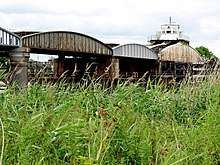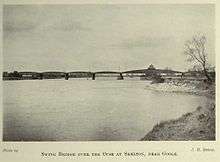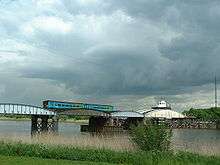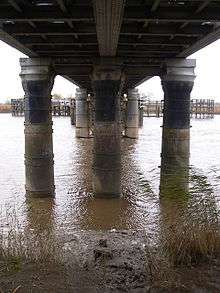Goole railway swing bridge
The Skelton Viaduct, also known as the Hook bridge or Goole railway swing bridge, is a large viaducted hogback plate girder bridge with swing span over the River Ouse, Yorkshire near Goole. The bridge was designed by Thomas Elliot Harrison for the Hull and Doncaster Branch of the North Eastern Railway and opened in 1869.

In the latter part of the 20th century, the bridge became known for the frequent incidents involving ship collisions with the superstructure. As of 2020, it is still in use.
History and description

During the 1860s, a number of attempts were made by different railway companies to create a new line better connecting Kingston upon Hull and South Yorkshire;[1] in 1862 the North Eastern Railway promoted a bill for a line which was unopposed by the Manchester, Sheffield and Lincolnshire Railway, and Lancashire and Yorkshire Railway on the understanding of mutual running powers for the companies, either to Hull, or on lines in South Yorkshire.[2] The bill, the "North Eastern Railway (Hull and Doncaster Branch)" was deposited late 1862, for a line from a junction on the Hull and Selby Line near Staddlethorpe (near Gilberdyke) to a junction with the South Yorkshire Railway near Thorne, Hatfield and Stainforth.[3] The act was passed in mid-1863.[2]
As part of the construction of the line, a bridge was required over the River Ouse near Goole between Skelton and Hook.[4]
Construction and design

The bridge consisted of four fixed spans, one swing span and a fifth swing span, and carried a double-track railway.[5][note 1]
Pier foundations for the bridge spans were of 7 ft (2.1 m) base diameter cast iron cylinders, which tapered to 5.5 ft (1.7 m) diameter at the high water level, each column was around 90 ft (27 m) long.[6] The piers were sunk into the river alluvium using a mass placed on them, and then by the pneumatic Caisson process until bedrock was reached. The tubes were then filled with Portland cement concrete to within 20 ft (6.1 m) of the top, the final fill was with brickwork with a top course of granite.[7] The river abuttments were of brick with stone dressing.[8]
The fixed spans were 116 ft (35 m) long, made of three wrought iron hogback plate girders each, resting on three piers.[9] The swing span was constructed of three hogback wrought iron box girders, each 250 ft (76 m) long, each box girder having a thickness of 2 ft 6 in (0.76 m) made of plates 0.3125 to 0.4375 in (7.94 to 11.11 mm) thick. In addition to the transverse deck girders the swing span was also braced by three transverse frames, which also served to support a bridgeman's hut over the centre of the bridge.[9]
The swing span was supported and turned on 26 conical rollers, which were supported by an annular box girder 38 by 36 in (0.97 by 0.91 m) high by wide, itself resting on six of the cast iron piers with approximately 29 ft (8.8 m) of the pier sunk into the river bed.[10]
The bridge rotated around a central column, which contained a hydraulic accumulator of 17 ft (5.2 m) stroke, with 16.5 in (420 mm) diameter ram loaded to 67 long tons (68 t), used to power the turning mechanism. The bridge was turned by a three-cylinder hydraulic motor (duplicated for redundancy), and gears. The accumulator was charged by 12 hp (8.9 kW) steam engines, also duplicated.[11] The engines were supplied by field boilers also located on the central pier.[12]
When in the closed position a hydraulic mechanism at either end of the bridge was used to lock the bridge in position.[13] The bridge could be opened in 50 seconds.[14]
The bridge superstructure was designed was T.E. Harrison of the NER, and erected by Pease, Hutchinson and Company (Skerne Ironworks).[15] The fixed spans were supplied by Butler and Pitts (Stanningley),[16][17] the hydraulic motors were of the design of Sir W.G. Armstrong.[18]
The swing span weighed 670 long tons (680 t), the weight of iron in the piers 922 long tons (937 t), with 770 long tons (780 t) of iron in the girders. The swing span opening was over 100 ft (30 m) in width, with a height above high water when closed of over 15 ft (4.6 m), The swing pier included a river jetty 200 ft (61 m) long.[19]
The bridge was crossed by NER officials in 1868,[20] and the line opened on 2 August 1869.[18]
Working history

On 21 March 1922, the river pier and engine room of the swing span was badly damaged by fire.[21][22]
In May 1933, the LNER had a miniature thumb switch controlled signalling frame installed at the bridge by Westinghouse,[23] at the same time the line from Staddlethorpe to Goole had colour light signalling installed; both were early examples of either technology in use. At the same time, two signal boxes at either end of the bridge were closed.[24][25][26]
The bridge has had several collisions with water-going ships.[24][27][28][note 2]
On 21 December 1973, the bridge was struck by a German coaster (Vineta IMO number: 8120923[28]), causing one of the spans to fall into the river, leaving the bridge unworkable for nine months.[24][30][31]
On 2 August 1976, Danish vessel Leon Sif (IMO number: 6711493) hit one of the bridge's piers.[32]
British Rail began closure procedures for the railway line due to costs associated repairing the bridge's pier, estimated at £2 million, coupled with a historic failure to get adequate compensation for damage to the bridge caused by shipping.[33][34]
In 1987, the structure was given a grade II* listing by English Heritage.[8]
On 23 November 1988, one of the fixed spans was pushed out of alignment by a collision with the Swedish vessel Samo (IMO number: 7016383), which became trapped between the bridge's piers.[28][35][36][37]
By the early 21st century, understrength girders and corrosion had led to the line speed over the bridge being reduced to 60 mph (97 km/h) for passenger trains, down to only 10 mph (16 km/h) for trains with a route availability of 9 or more. In 2009, a modernisation programme began – Clancy Docwra installed services (telecoms, fresh and waste water, electricity, signalling) to the central pier through piping under the river bed. Carillion was appointed main contractor in March 2010. The bridge steelwork was repaired and upgraded over a six-week line closure starting in October 2010 – over 400 tonnes of steelwork was installed including diagonal transverse braces, and stiffening to the girders of the web. Additional work included track renewal and painting of the bridge. The total cost of the project was £6 million; the firm of Pell Frischmann was the designing engineer.[38]
For quite some time the pages of the Yorkshire Ship Enthusiasts' Newsletter have enthralled their members by recounting the efforts by numerous vessels to demolish the railway bridge at Hook, near Goole
— Sea Breezes ~ The Ship Lovers' Digest, Vol. 36
See also
- Similar bridges
- Naburn swing bridge (York and Doncaster Line)
- Selby swing bridge (1891) (Hull and Selby Line)
Notes
- The swing bridge runs east west, the swing section is closer to the east bank of the river. (Ordnance Survey, 1891, 1:2500)
- Between 1981 and 1991, the bridge had strikes causing damage on 22 occasions. Only the 23 November 1988 incident caused a long-term closure.[29]
References
- Tomlinson 1915, pp. 553, 589, 593, 606–608.
- Tomlinson 1915, pp. 608–9.
- "North Eastern Railway. (Hull and Doncaster Branch)", London Gazette: 5614–5616, 21 November 1862
- Tomlinson 1915, p. 636.
- Armstrong 1869, p. 124, Plate. 17.
- Armstrong 1869, pp. 123,124.
- Armstrong 1869, p. 128.
- Historic England. "Railway Swing Bridge Over River Ouse (1346710)". National Heritage List for England. Retrieved 12 May 2015.
- Armstrong 1869, p.124, Plate. 17.
- Armstrong 1869, pp.123–4, Plates. 17–22.
- Armstrong 1869, p.124-5, Plates. 19–21,23.
- Armstrong 1869, p. 129.
- Armstrong 1869, pp.125–7, Plate. 24.
- Armstrong 1869, p. 127.
- "Swing bridge over the River Ouse; North-Eastern Railway", Engineering: 264–265, 27 October 1871
- Sheardown, Doncaster in 1869, p.72
- "Railway Bridge over the River Ouse" (PDF), The Engineer, vol. 27, p. 157, 26 February 1869 , errata 12 March 1869, p.195
- Sheardown, Doncaster in 1869, p.71
- "Opening of the Hull and Doncaster Railway", The Railway News and joint stock journal, 12 (294): 157, 14 August 1869
- Sheardown, Doncaster in 1868, p.63
- The Railway Gazette, 36: 540, 574, 578, 1922 Missing or empty
|title=(help) - "Railway Bridge, Goole", Hansard, 152, cc953-4, 27 March 1922
- Duffy, Michael C. (2003), Electric Railways 1880–1990, IET, p. 200, ISBN 0852968051
- Hoole 1986, p. 41
- "Installation of Colour Light Signalling Between Staddlethorpe and Goole", London and North Eastern Railway Magazine, 23: 351, 1933
- Signalling Study Group (1986), The Signal Box: A Pictorial History and Guide to Designs, Oxford Publishing Company, p. 206; p. 77, Plate. 102, ISBN 0860932249
- See Breezes: The Ship Lovers' Digest, 63, 1989, p. 423,
For quite some time the pages of the Yorkshire Ship Enthusiasts' Newsletter have enthralled their members by recounting the efforts by numerous vessels to demolish the railway bridge at Hook, near Goole
- "Goole Update", Ships Monthly, 24: 47, 1989,
There is yet more to report concerning the now notorious swing railway bridge .. at Goole [...] On the first occasion the German coaster Vineta (1981/499grt) passed through during the early hours of 21st November, but, in doing so, holed herself — fortunately above the waterline [...] in good visibility — the Swedish Samo (1970/1, 197grt), laden with timber for Howdendyke, somehow missed the span opened for her and instead ran under one of the fixed spans
- "Goole Railway Bridge", Hansard, 189, cc419-420W, 23 April 1991
- "PROVISIONS RELATING TO BOOTHFERRY BRIDGE", Hansard, 14, cc441-63, 3 December 1981,
cc.443 "Shortly before Christmas 1973, a ship collided with the railway bridge at Goole and demolished one of the central spans of the bridge, which was as a consequence out of action for nine months. That caused great inconvenience to railway passengers because Goole was at the end of a branch line. It also proved expensive for British Rail"
- "Goole Swing Bridge restored", The Railway Magazine, 120–121: 613, 1974,
Full normal train services were restored over Goole Swing Bridge ... from October 7. The bridge was put out of action on December 21, 1973 when it was struct by a German coaster..
- "Ship Strikes Ouse Bridge", Ships Monthly, 11–13: 5,
The swing railway bridge which crosses the river Ouse upstream of Goole was put out of action once again in August after being struck by a ship. In the early hours of Monday, 2nd August, the Danish motor vessel Leon Sif, inward bound for Howdendyke, hit one of the bridge's supporting piers
- "Rotten jetty shuts main line to Hull", New Scientist, 101 (1392): 8, 12 January 1984
- "Merchant Shipping (Miscellaneous Provisions) Bill [Lords]", Hansard, 54, cc1002-11, 23 February 1984,
Peter Snape: British Rail has failed consistently over the years to receive adequate compensation for damage caused to the bridge, and it now says that it will cost approximately £2 million to repair the bridge. Because British Rail says that it cannot afford £2 million and there is no other source of funding for the project, it has initiated the closure procedure for that stretch of railway line
- The Railway Magazine, 135: 79, 1989 Missing or empty
|title=(help) - "Goole Swing Bridge", www.engineering-timelines.com, archived from the original on 2 November 2013,
In 1988, it was struck by a 356 tonne ship causing two of the approach spans to move up to 6m out of line. Part of the superstructure was replaced
- Marine News, 43: 54, 1989,
SAMO. 1,197/70 — m.v. owned by B.R.I. Bengtsson. Sweden, suffered comparatively little damage when she went between the wrong two piers of the Hook railway bridge near Goole 23/11/88 and became trapped. The bridge, however, suffered considerable damage
Missing or empty|title=(help) - Rail Engineer magazine (7 January 2011). "Goole bridge refurbishment". www.rail.co. Archived from the original on 16 June 2012. Retrieved 7 November 2013.
Sources
- Armstrong, W. G. (1869), "Description of the hydraulic swing bridge for the North Eastern Railway over the River Ouse near Goole", Proceedings of the Institution of Mechanical Engineers, Institution of Mechanical Engineers, 20 (1869): 121–126, doi:10.1243/PIME_PROC_1869_020_013_02, Plates: 17-24
- Hoole, Ken (1986) [1965]. A regional history of the railways of Great Britain. Vol 4, The North East (3 ed.). David and Charles.CS1 maint: ref=harv (link)
- Sheardown, William (1864, 1865, 1866, 1867, 1868, 1869). Doncaster in 1864 (1865,1866,1867,1868,1869) : its meteorology, vital statistics, town improvements, markets, railway system etc. etc. Brooke, White and Hatfield. Check date values in:
|year=(help) - Tomlinson, W.W. (1915). The North Eastern Railway; its rise and development. Andrew Reid and Company, Newcastle; Longmans, Green and Company, London. pp. 634–6.CS1 maint: ref=harv (link)
Literature
- Taylor, Mike (2002), "3. Goole to Selby", The Yorkshire Ouse Navigation, Tempus Publishing, pp. 43–46, ISBN 0 7524 2369 X
External links
| Wikimedia Commons has media related to River Ouse railway bridge, Goole. |
- "SAMO – IMO 7016383", www.shipspotting.com (image), SAMO stuck under Ouse bridge, 1988
- Gallery – Goole swing bridge (image), Network Rail, archived from the original on 4 November 2013, gallery of 2010 improvement works